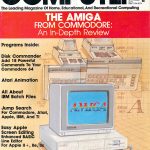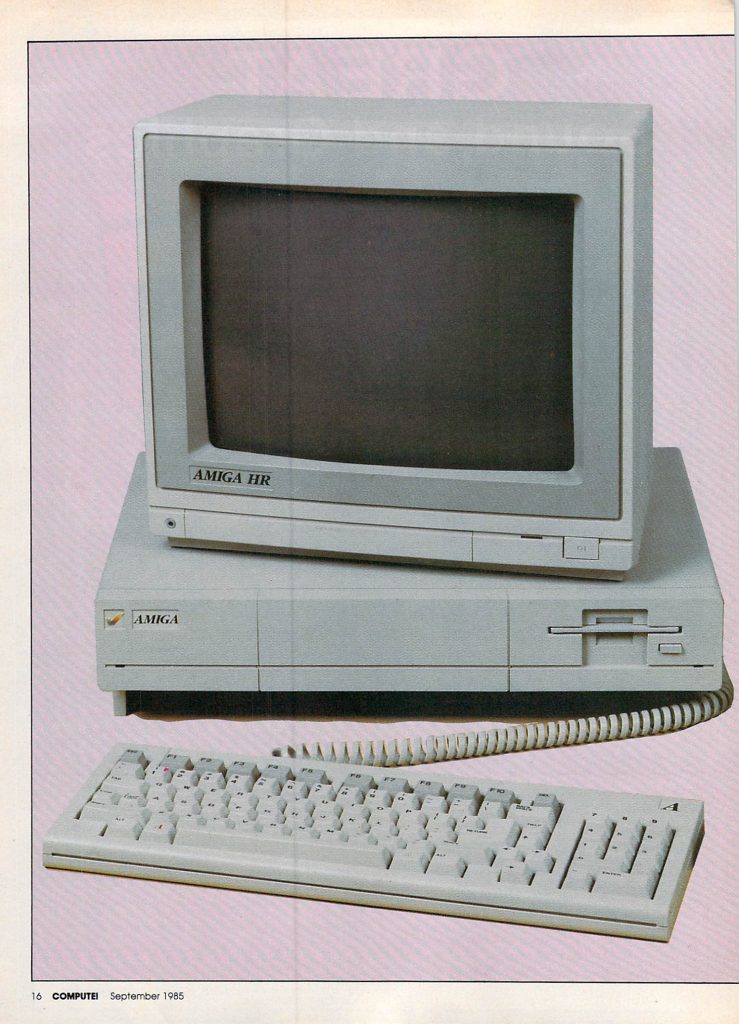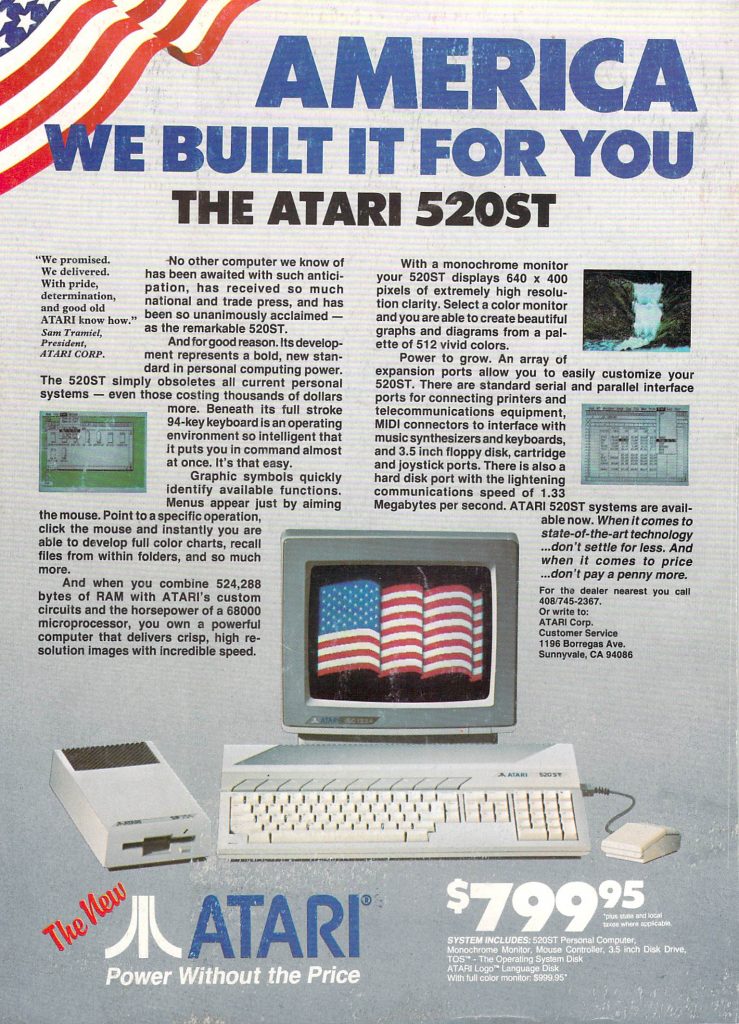
- Tag Archives atari
-
-
 Compute! (September 1985)
Compute! (September 1985)
Compute! was probably the best magazine for the average computer user in the early to mid 1980s and perhaps beyond. At least if you had an interest in more than one platform. Compute! covered all of the popular home computers of the time and there were a bunch in 1985 including the Commodore 64, Apple II, Atari 8-bit, PC, TI-99/4A, the brand new Amiga and Atari ST, and probably others. The September 1985 issue includes:
Features
- The Amiga: An In-Depth Review – A detailed look at the new Amiga (Amiga 1000) from Commodore. It was due to be released in August.
- The Electronic University – While it took a while for online education to really take off, it is far from new. This article tells the story of one family who is using their Commodore SX-64 to earn online degrees.
- The Last Warrior – A type-in arcade style action game for hte PC, Commodore 64, Atari 400/800, and Apple II.
Reviews
- Rescue on Fractalus! and Ballblazer – Reviews of these two classic Lucasfilm games for Atari 8-bit computers.
- Below the Root – An adventure game for the Commodore 64 based on the Green Sky Trilogy of books.
- Companion – A word processing program for the TI-99/4A.
- Jr-Draw for PCjr – An art program designed for the PCjr that can optionally use a light pen.
Columns and Departments
- The Editor’s Notes – A discussion of the Amiga, BASIC, machine language, and the C programming language.
- Readers’ Feedback – Letters from readers about relational operators, Atari tape to disk transfer, adding beeps to key presses on the Commodore 64, unlocking IBM PC BASIC programs, and more.
- HOTWARE: Software Best Sellers – Best selling software this month includes Flight Simulator II (Entertainment), Math Blaster! (Education), and Print Shop (Home Management).
- The Beginner’s Page: Forget Your Algebra – It turns out you don’t need an extensive math background to program a computer.
- Computers and Society: Compilers, Interpreters, and Flow: Conclusion – How different compilers and interpreters affect program flow and complexity.
- Telecomputing Today – SIG Wars – Special Interest Group sysops switch between services while those services claim ownership of all messages and uploaded files in a SIG.
- The World Inside the Computer: A Robot Toddler – A look at the Herojr personal robot.
- IBM Personal Computing: The Mysterious Editors – A look at the editors that IBM provides with its PCs including BASIC, DEBUG, and EDLIN.
- Programming the TI: The OPEN Statement – Some examples of using the OPEN statement on the TI-99/4A.
- INSIGHT: Atari – Using Serial Input/Output – A look at how printing and disk access works via SIO.

The Journal
- Commodore 64 Memory Manager – A type-in program for the Commodore 64 that allows you to load multiple BASIC programs into memory at once and switch between them.
- Saving Time and Memory: An Atari Variable Utility – A set of type-in utilities for the Atari 8-bit that allows you to list, rename, and abbreviate variable names in BASIC programs.
- Commodore 64 Disk Commander – A type-in utility for the Commodore 64 that makes disk access more convenient.
- Apple Fractals – A type-in program for generating fractals on the Apple II.
- Chess for IBM PC & PCjr – A type-in chess program for the PC and PCjr based on an earlier published version for other machines.
- Commodore Bootstrapping – A tutorial and demo for how to load programs that are divided into multiple parts on the Commodore 64, VIC-20, C16, PET/CBM, and Plus/4.
- Atari Animation with P/M Graphics, Part 1 – The first part of an animation tutorial for the Atari 8-bit using Atari’s Player/Missile graphics.
- All About IBM Batch Files, Part 1 – The first part of a tutorial for using DOS batch files.
- Jump Search – A demonstration of binary search on the Atari 400/800, Apple II, IBM PC, Commodore 64, TI-99/4A, and Color Computer.
- 128 Sound and Music, Part 2 – This part explores the Commodore 128’s FILTER, SOUND, and PLAY commands.
- Easy Apple Screen Editing – A type-in screen editor for the Apple II.

…and more!
-
 Compute! (August 1987)
Compute! (August 1987)
Compute! was a multiformat magazine that covered a variety of popular machines. It was one of the better magazines in this category, especially if you wanted something more home computer oriented and a little less technical than Byte. The August 1987 issue includes:
Features
- Compute!’s Readership Survey – A survey for readers that asks questions like what kind of computer you use, what kind of applications, etc. This was used in part to determine coverage in future issues.
- CES and COMDEX: A Tale of Two Cities – Comparing the Consumer Electronics Show in Chicago with COMDEX in Atlanta. Both were big shows for electronics and computer software and hardware.
- >Climber 5 – A type in game for the Commodore 64, Atari, Amiga, Apple II, and PC in which you must climb to the top of a building to retrieve a baseball while avoiding various obstacles.
Reviews
- Bank Street Writer Plus – A word processor for the Apple II line and the IBM PC.
- Might and Magic – The classic fantasy RPG reviewed here for the Apple II.
- Space M+A+X – A simulation in which you must make money operating a space station for the IBM PC.
- Realms of Darkness – Another role-playing game, this one from Strategic Simulations (SSI) for the Apple II and Commodore 64.
Columns and Departments
- The Editor’s Note – Recent advancements in superconductivity and its implications for computing.
- Readers’ Feedback – Readers write in about the future of 5.25″ disks, checking the CAPS key on the Atari 130XE, the importance of saving a typed-in program before running it, upgrading an Amiga CPU, and more.
- Computers and Society: The Next Gutenberg Revolution – Desktop publishing becomes more affordable with the introduction of Atari’s laser printer for the ST.
- The World Inside the Computer: Robert Evans Meets the Xerox 4020 – A look at a new printer from Xerox featuring ink jet technology.
- Microscope – A look at IBM’s new PS/2 line (an their marketing), and some comparisons with the Atari ST and Amiga.
- Telecomputing Today: A Conversion Experience – Issues converting an old MacWrite disk to a new system with a utility download coming to the rescue.
- The Beginner’s Page: Program Loops – A look at GOTO, FOR-NEXT, and WHILE-END loops in BASIC.
- IBM Personal Computing: What to Do About Junior – The merits of upgrading a PCjr (or lack thereof) vs. getting a whole new PC.
- AmigaView: All About Icons – Creating your own icons.
- ST Outlook: Page Flipping – A tutorial for flipping between multiple display screens.
- INSIGHT: Atari – Graphics: From BASIC to ML – A look at how Atari BASIC converts graphics commands to machine language.
The Journal
- 64 Eighty – A type-in program that will give you an 80-column display on the Commodore 64. A similar software trick was used in a terminal program I used back in the day. It’s not as high quality as a genuine 80-column displays (the C64s native display is 40 columns) but it was pretty good.
- BASIC Batch Files with Atari DOS – How to execute BASIC commands (or other things) upon startup.
- Math Graphics for Atari ST – A couple of type-in graphics demos for the ST.
- Compress and Decompress – A couple of type-in utilities for compressing and decompressing high-res graphics files on the Apple II.
- Fractal Mountains for Amiga – A type-in program that will generate fractal graphics on the Amiga.
- Pop-Up ASCII Table for IBM – A type-in utility that runs in the background and will give you a pop-up ASCII table on a keypress.
- XpressCard Filing System for the Commodore 64 – A type-in database program for the C64.
- ML Relocator – A type-in machine language utility that will let you move ML programs around in memory that normally need to use the same memory space.
- SoftSprite – A type-in machine language routine that adds commands to BASIC that allow you to quickly move shapes around the screen.
- The Power of ON-GOTO and ON-GOSUB – A tutorial for using the conditional ON-GOTO and ON-GOSUB commands in BASIC on the Atari (and most other machines with BASIC).
- Chaining Programs in Applesoft BASIC – A tutorial for calling one program from another.
- The 128’s CHAR Statement – A detailed look into the BASIC CHAR statement on the Commodore 128 by Jim Butterfield.
- Comparing BASIC Programs – A type-in BASIC program for the PC that will compare two BASIC programs and report any differences. So basically a diff program for BASIC.
- News and Products – Life Simulation 100 is a sim of possible consequences based on various choices; Diskette Manager Plus 1.1 and Diskette Manager II disk manager for the PC; Time Scrolls for the Mac reports on what happened the day you were born; Up Periscope and Sentry games for the Commodore 64; and much more.

…and more!





